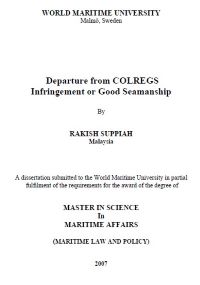DEPARTURE FROM COLREGS — INFRINGEMENT OR GOOD SEAMANSHIP

| Author(s) | Rapish Suppiah |
| Publisher | WMU |
| Date | 2007 |
| Pages | 115 |
| Format | |
| Size | 1 Mb |
| D O W N L O A D | |
Despite all recent technological advancements in the field of provision of marine safety, including the newest e-navigation tools and modern satellite systems, as well as the perfectly developed training methods for contemporary navigators, maritime collisions continue to remain a prominent issue in major maritime casualty statistics. While collisions may not always be the leading cause within these statistics, when they do occur, they often lead to significant losses.
These incidents can result in severe consequences, including loss of life and personal injury, marine pollution, fire, explosions, cargo loss, and property damage. A maritime collision is defined as "the violent encounter of a moving body with another." Notably, collisions at sea do not necessarily involve direct contact between two vessels; they may also occur between a vessel and structures such as bridges, wharfs, or cranes. Such incidents are classified as 'allisions'. The foundation of maritime collision law can be traced back to ancient Roman law, which lacked specific navigational rules apart from customary maritime practices and jurisprudence regarding fault and liability for loss or damage. In 1840, the Trinity House navigational rules were established, followed by the first UK statute to incorporate navigational rules in 1846, which evolved alongside additional statutory regulations in 1851, 1854, and 1858.
The first diplomatic conference focused on navigational rules took place in Washington in 1889, convened by U.S. President Benjamin Harrison, resulting in the first comprehensive set of international navigational regulations that came into effect in 1897. Subsequent conferences in Brussels in 1910 and London in 1948 and 1960 made further revisions to the international collision regulations. A significant overhaul occurred in 1972, led by the International Maritime Organization (IMO), culminating in the Convention on the International Regulations for Preventing Collisions at Sea, known as COLREGs 1972. These regulations have been adopted by nearly all maritime nations and are "applicable to all vessels upon the high seas and in all waters connected therewith."…
The "Read Later" function allows you to add material to this block with just one click. Just click on the icon and read the articles that interest you at any convenient time.


